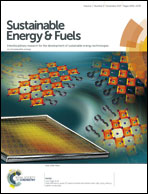Formation of an external char layer during subcritical water hydrolysis of biomass†
Abstract
Flow-through subcritical water hydrolysis (FT-SWH) consists of flowing hot liquid water over a fixed bed packed with biomass particles to produce fermentable carbohydrates and other valuable small molecules. In this work, we studied FT-SWH of green coffee powder as a model lignocellulosic feed, investigating temperatures in the range from 150 to 250 °C and 22.5 MPa. Batch SWH was performed as a basis of comparison for the FT-SWH tests. The focus of the study was characterization of the treated solids; specifically, bulk (primarily thermogravimetric analysis, TGA) and surface (both attenuated total reflectance infrared Fourier transform spectroscopy, ATR-FTIR, and Raman microscopy) methods were used to investigate the hemicellulose, cellulose, and lignin content of the solids. Bulk analysis indicated that the solids treated under FT-SWH conditions retained substantial holocellulose content, even when treated under the most aggresisve FT-SWH conditions studied here (250 °C). On the other hand, surface analysis indicated that the treated materials were primarily composed of char, with the surface content of bound carboxylic acids also increasing with increasing hydrolysis temperature. To understand the apparent discrepancy between bulk and surface analysis, the cross sections of the treated samples were analyzed using both FTIR and Raman microscopy. These techniques confirmed that the surface consisted of a char material, whereas the particle interior was primarily holocellulose. Formation of the external char layer seems to prevent hydrolysis of the internal holocellulose, limiting sugar yields. In comparison with FT-SWH, batch SWH at a similar severity factor resulted in reduced sugar yields, decreased the onset temperature for formation of detectable char quantities, and increased char formation. Comparison with batch conditions suggests that flow conditions reduce external char formation but do not prevent it. This study explains the benefits of FT-SWH and inform development and refinement of pretreatment technologies that can reduce char formation rates.



 Please wait while we load your content...
Please wait while we load your content...